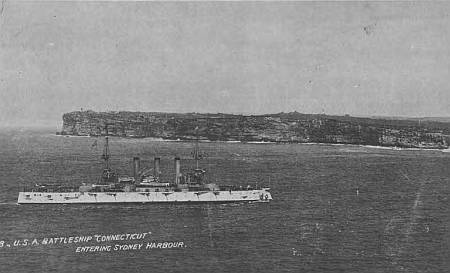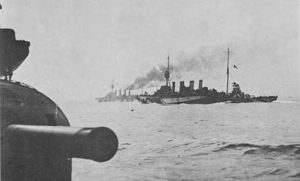- Author
- Henderson, Captain C.W.
- Subjects
- Early warships, Ship histories and stories
- Tags
-
- RAN Ships
- HMAS Encounter I, HMAS Warrego I, HMAS Yarra I, HMAS Australia I, HMAS Sydney I, HMAS Parramatta I, HMAS Melbourne I
- Publication
- August 1972 edition of the Naval Historical Review (all rights reserved)
Whatever happened to those famous old fighting ships of World War I? Captain Henderson, a former Sydney pilot and a historian of note, draws on nostalgic memories in tracing the diverse end of the more notable.

THIS STORY MUST BEGIN with the arrival of the largest battleship fleet to visit Australia – 16 battleships and 21 other vessels of the US Navy’s Great White Fleet on August 20 1908, on their world cruise. Another American squadron entered our Heads on July 23 1925. Visiting Sydney on this occasion were the USS California (the flagship), Colorado, Idaho, Maryland, Mississippi, Tennessee and West Virginia. This fleet departed on August 6 1925.
Founder of the Manly Art Gallery, Sydney artist Charles Bryant, was noted for his marine work, and he was commissioned by the NSW Government to paint a large canvas of the fleet’s visit to Sydney as a gift from the Australian people to the American nation. It now hangs in the Capitol Building, Washington.
One other fleet of more importance to our nation to enter the harbour was the fleet of our first Royal Australian Navy. This was on October 4 1913, under the command of Rear-Admiral Sir George Patey.
The title Royal Australian Navy was granted by King George V in 1911, the year the battle-cruiser HMAS Australia was launched on the Clyde.
In 1913, Admiral Sir Geo. King-Hall RN hauled down his flag to bring British responsibility on the Australian station to an end.

The most recent fleet entry into Sydney Harbour was on November 22 1969, when Manly ferry passengers were privileged to view warships from four Commonwealth navies. The flagship of the RAN, HMAS Melbourne, led navies from Britain, Australia, Canada, and New Zealand (17 ships and one submarine in all) into harbour after combined exercises at sea.
But it is of the famed fighting ships of World War I that I now wish to write. Our first flagship, the battle-cruiser HMAS Australia, flying the Rear-Admiral’s flag, led into the harbour the cruisers Melbourne, Sydney and Encounter and the destroyers Warrego, Parramatta and Yarra, in that order. They represented a navy which had been created on July 10 1911.
I comment on them all now as they came in.

HMAS Australia, launched on the Clyde in 1911, was commissioned in 1913. She carried eight 12-inch guns and had a speed of 26 knots. With HMAS Melbourne, she captured German Samoa in August 1914. She sank the German Elenore Woermann off the Falkland Islands in January 1915. In 1917, HMAS Australia became flagship of 2nd Battle-Cruiser Squadron. She was the first ship to launch aircraft from a specially constructed platform on deck. In 1921 she was paid off under the terms of the Washington Disarmament Treaties and was scrapped. Mr. L. J. Lind, of the Naval Historical Society, described as the ‘blackest day in our history, April 12 1924, the day we scuttled our capital ship’. She was only 11 years old and still a modern ship of 19,000 tons. The Australian flag and White Ensign which went down with her off Sydney Heads were those which she bore throughout her career. Her decks were covered with a mass of floral tributes sent by people who were proud of their first Australian flagship.
First of the cruisers following was HMAS Melbourne. Commissioned in 1913, she was of 5,400 tons, and had a speed of 25.5 knots. She saw action in the South-West Pacific and the North Sea, and was present at the surrender of the German Fleet at Scapa Flow in 1918. Paid off at Portsmouth in 1928, she was sold to shipbreakers there for scrap.




